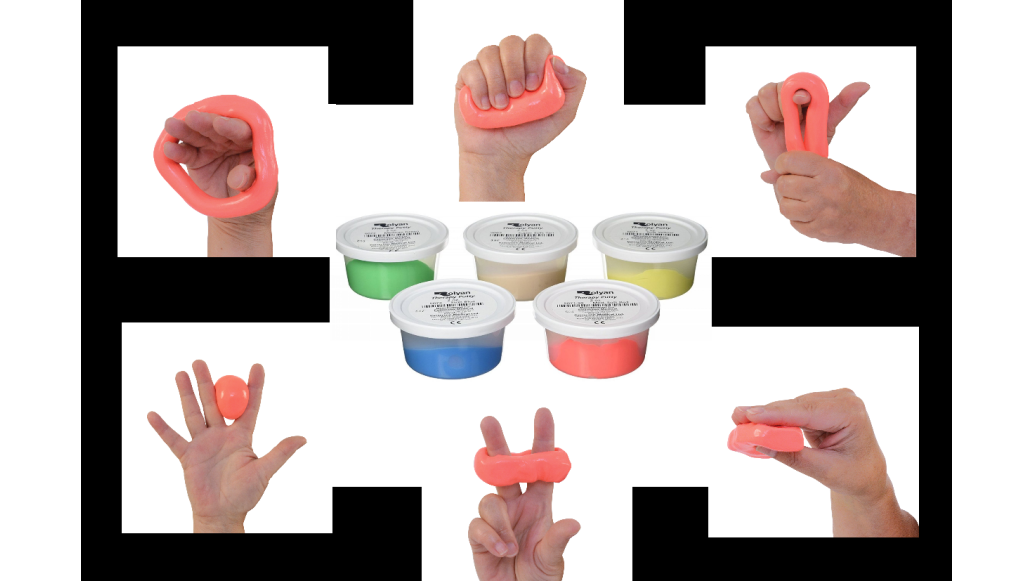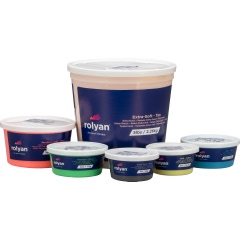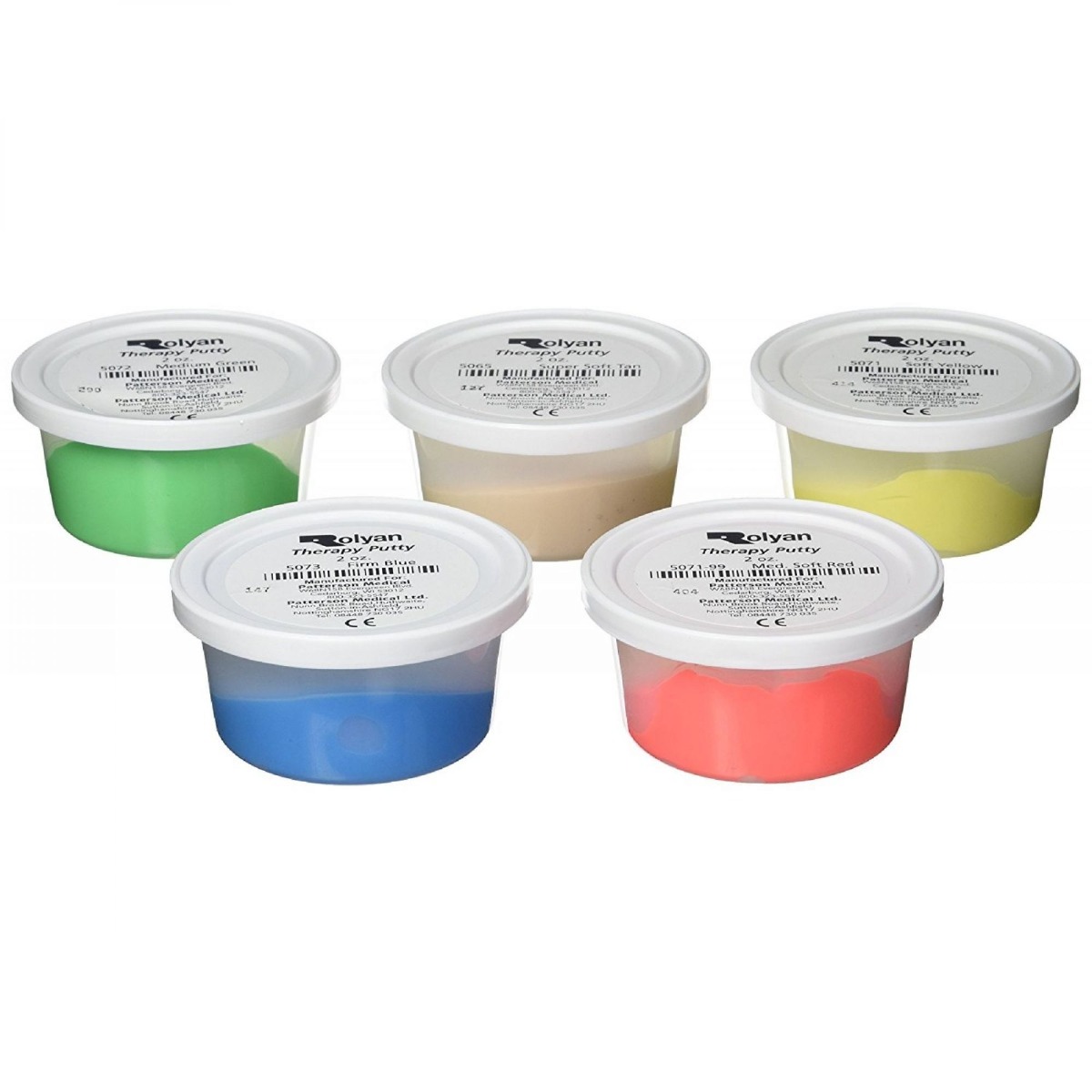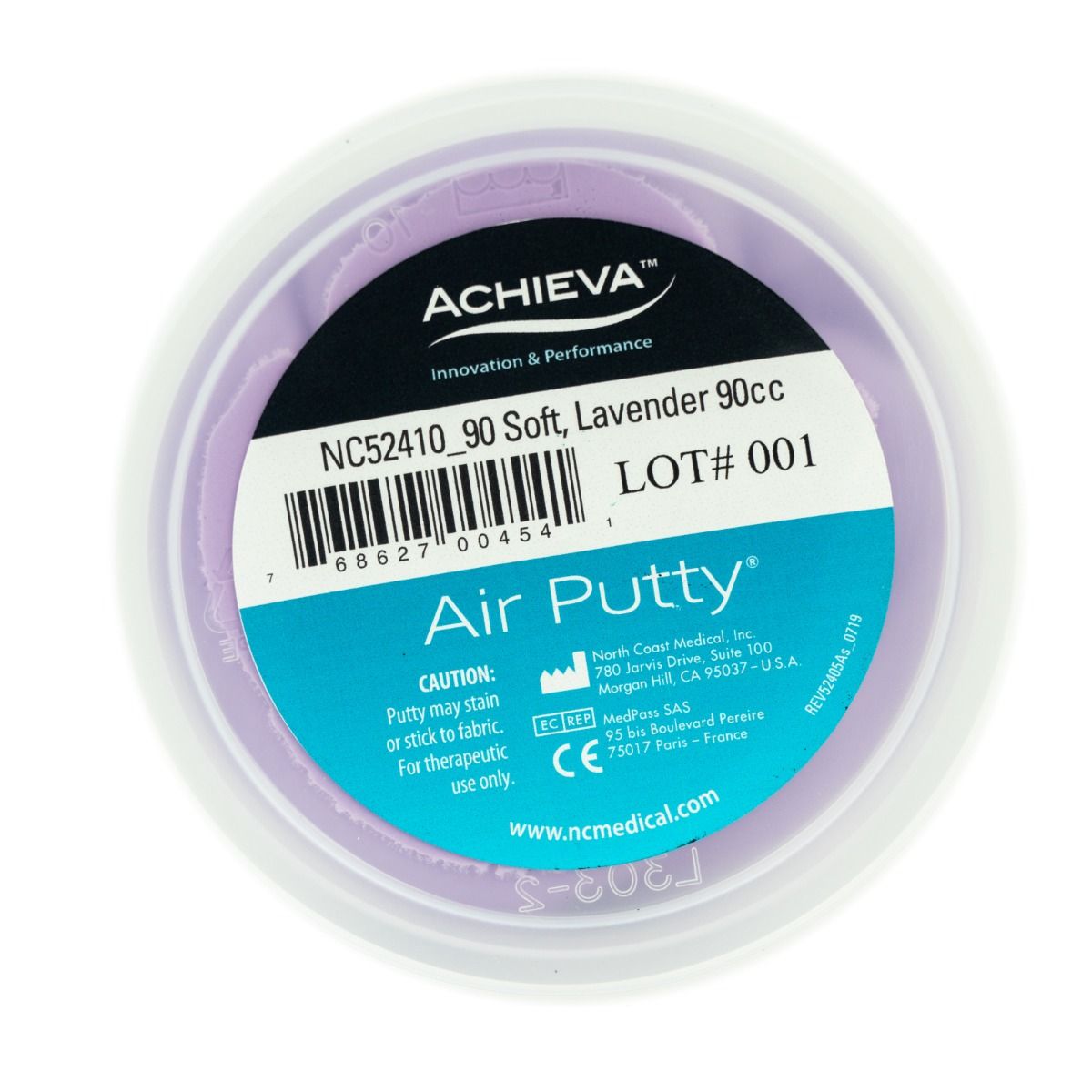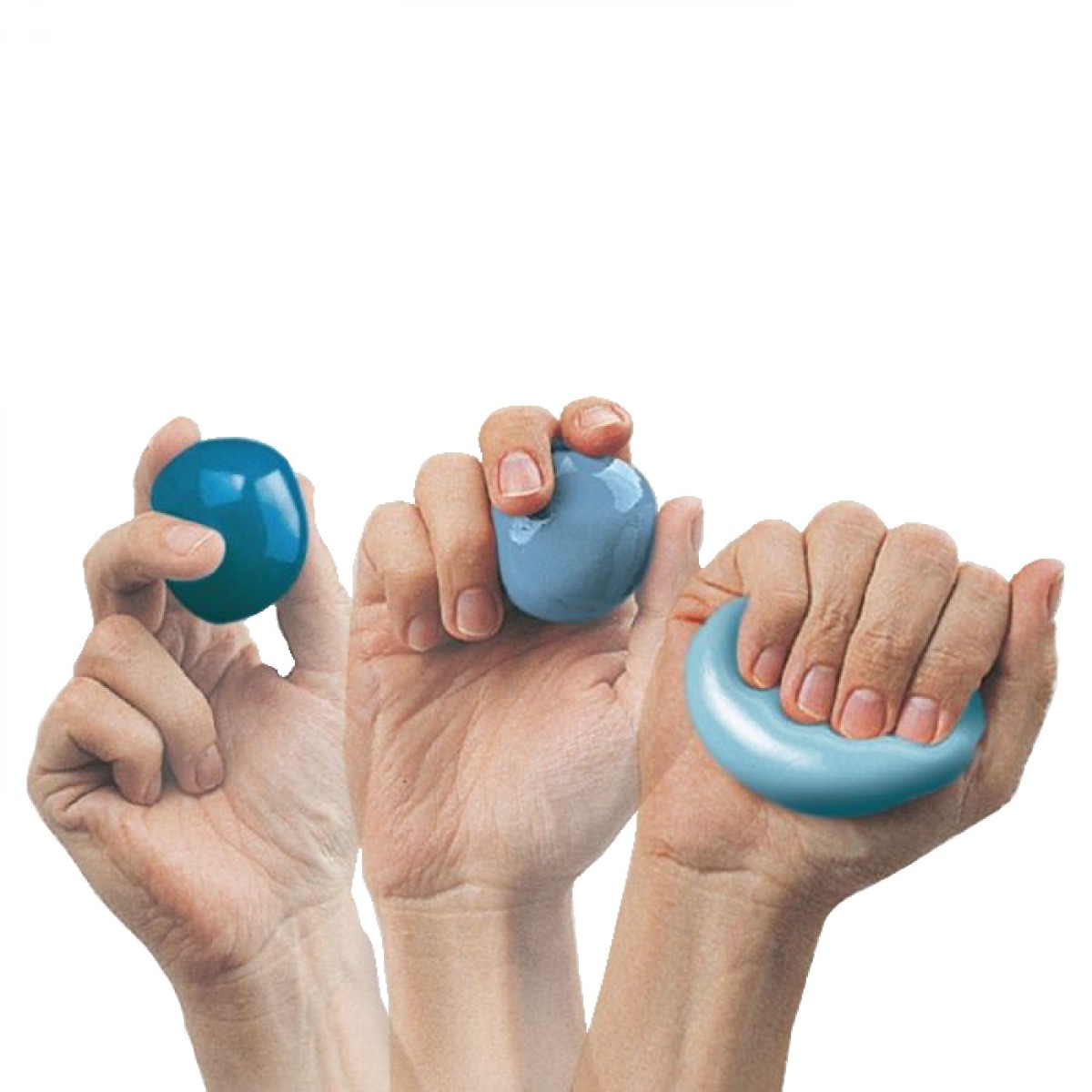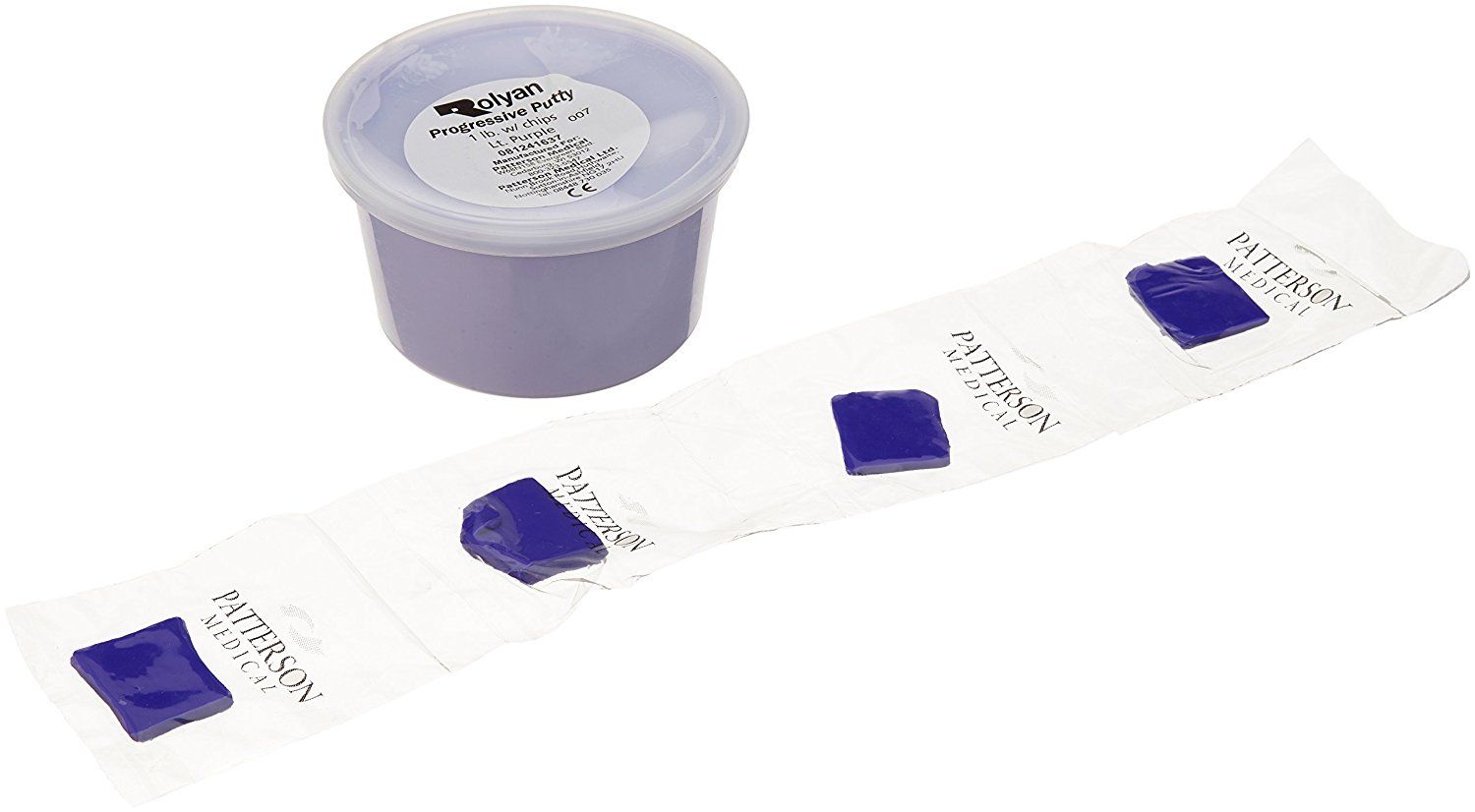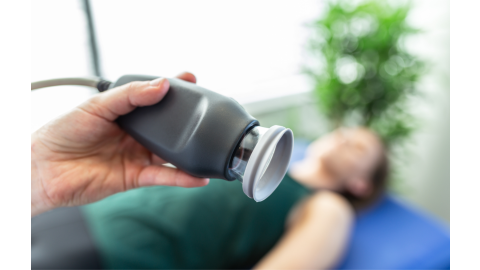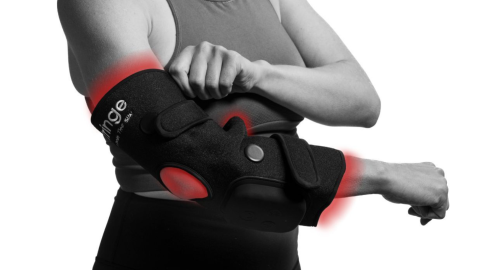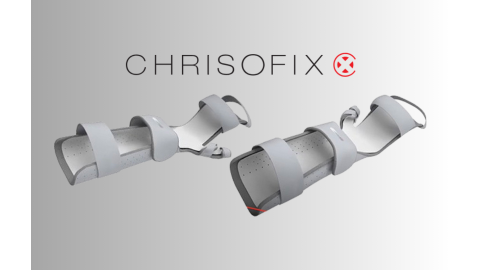Does your child need to strengthen their grip strength or pinching skills? Learn how therapy putty can help!
- What’s the difference between therapy putty, silly putty, playdough, and slime?
- Why do people use therapy putty?
- What skills do children build when using therapy putty?
- Why do these skills matter?
- 25 Therapy Putty Exercises & Activities
- How to Choose the Right Therapy Putty
What’s the difference between therapy putty, silly putty, playdough, and slime?
Playdough holds its shape; this allows it to be used for building and molded with tools for play. If you leave it out, it will harden.
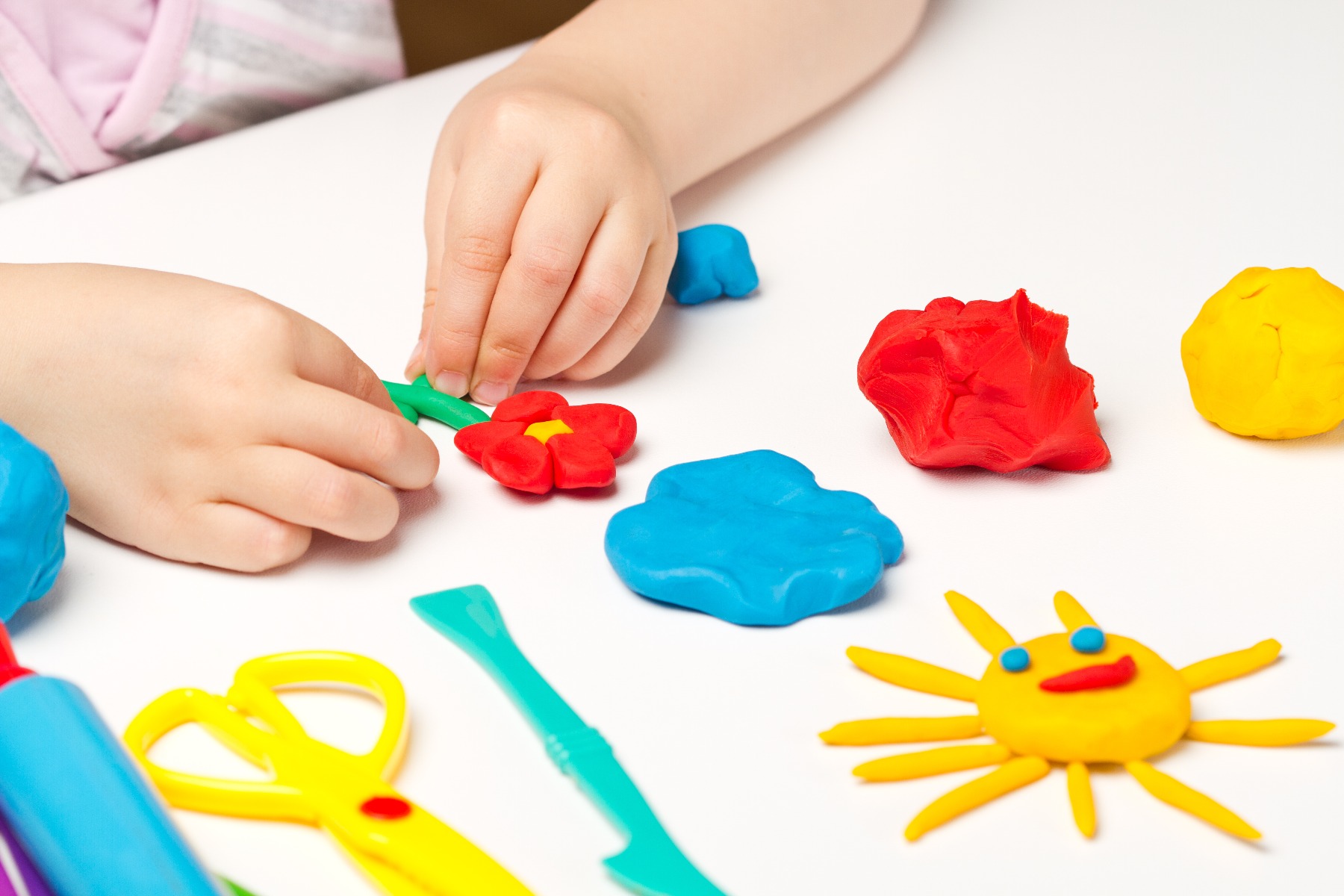
Silly putty can be stretched, squished, and twisted, but it doesn’t hold a shape as well. It also doesn’t dry out when exposed to air like playdough will. If you put in on newspaper, it used to pick up images and words (like in the picture below). Now with changes made to the ink used to print papers, silly putty will no longer do this, but it will pick up pencil marks!
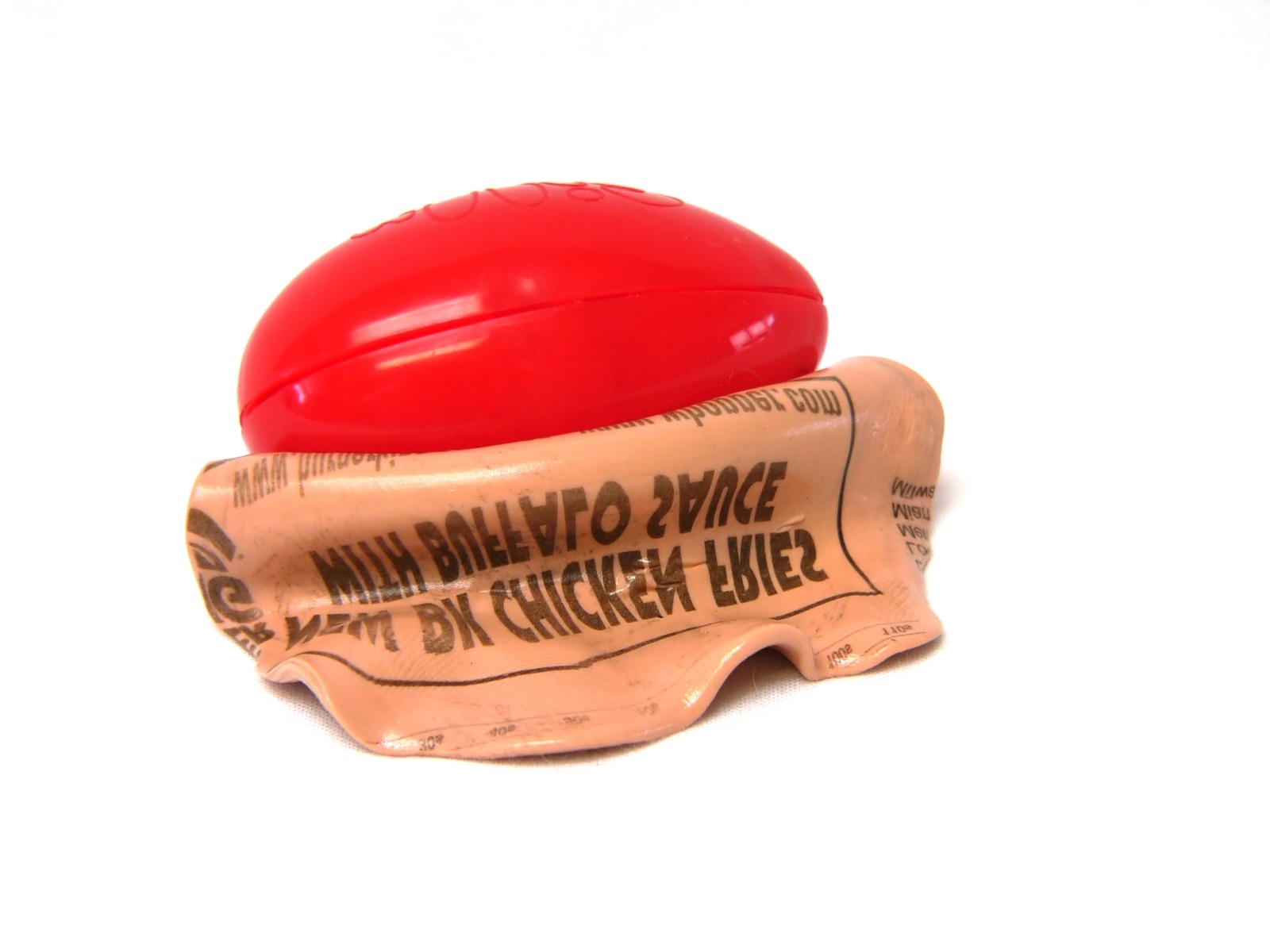
Therapy putty is much more similar texture-wise to silly putty than playdough. But it’s designed for hand therapy and strengthening and comes in resistances that are both softer and harder resistances than silly putty. This allows the putty to be used for rehabilitation and strengthening.
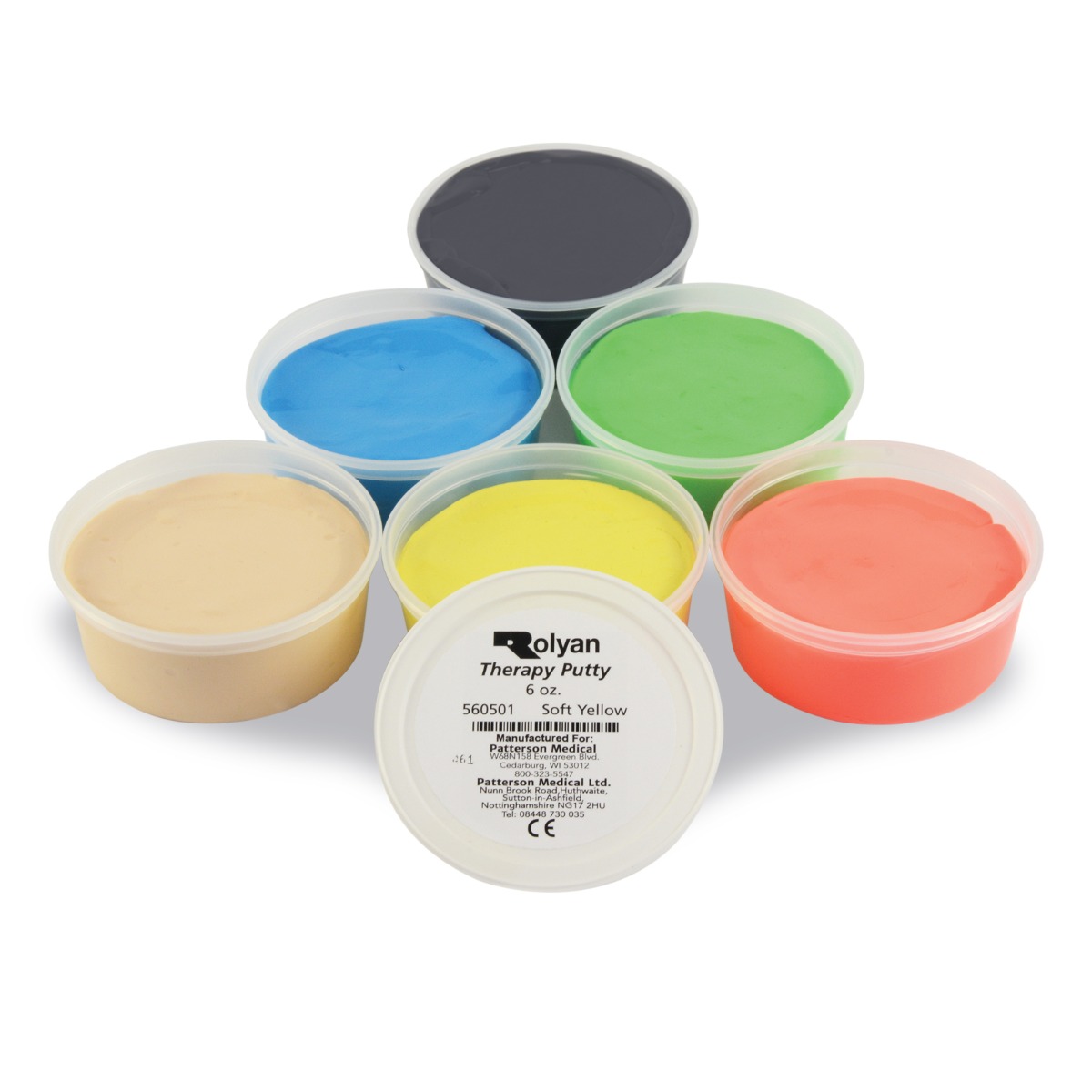
Slime is ooey-gooey and drippy and while it can be a fun sensory toy, it can’t be used for much other creative play. It also tends to be the messiest of the bunch.
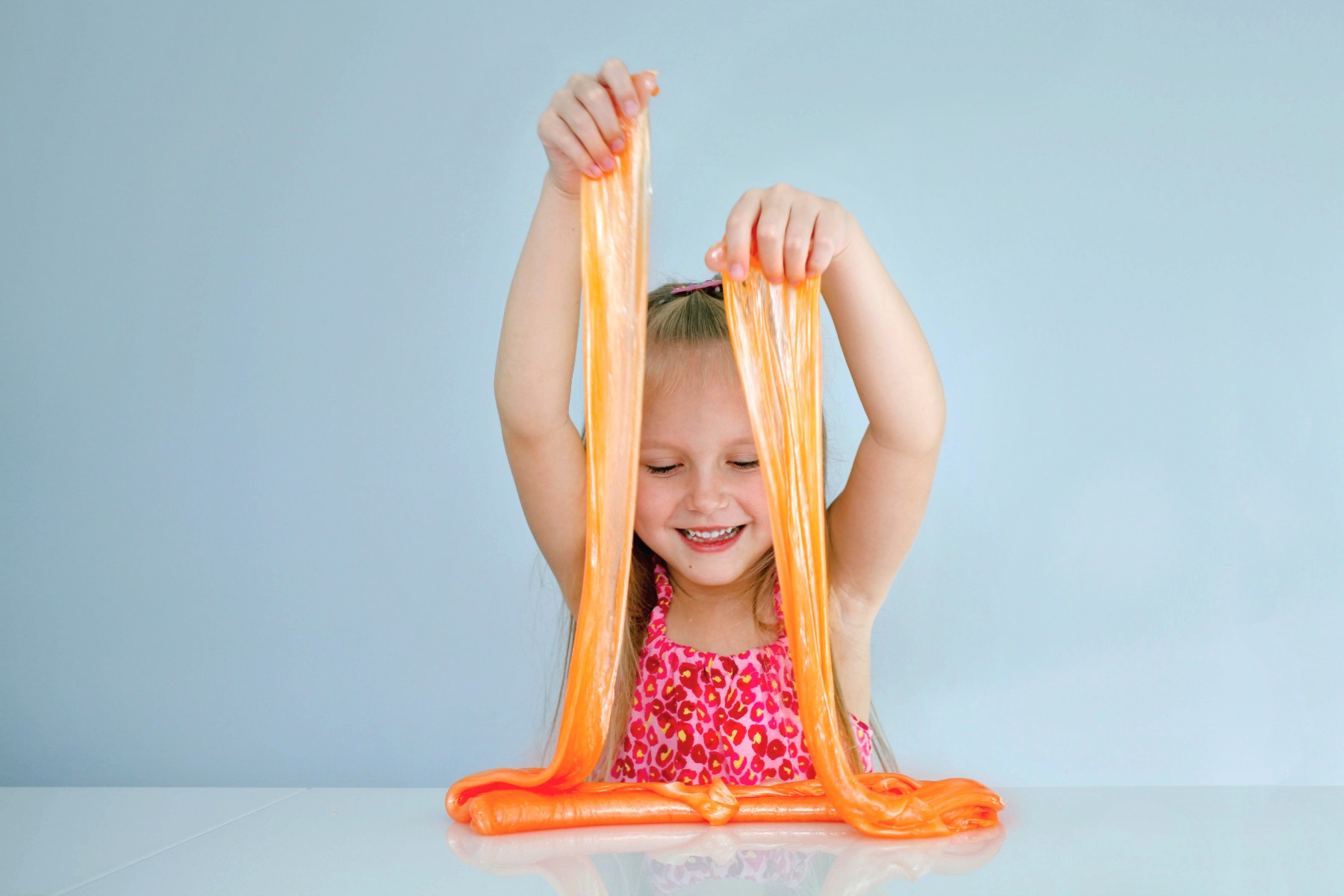
While all four can make fun toys and add variety to your sensory play, if your child is looking to improve their hand strength, therapy putty is the best choice.
Why do people use therapy putty?
Therapy putty is used for strengthening hand grip and finger strength. It’s commonly used during rehabilitation to improve hand strength after an injury, illness, surgery, stroke, or for people with other disorders that affect muscle tone and grip strength.
It’s also used by children at home and in occupational therapy sessions to build hand strength and other skills. It may be used by children with autism, ADD, ADHD, cerebral palsy, or other conditions that affect hand strength.
What skills do children build when using therapy putty?
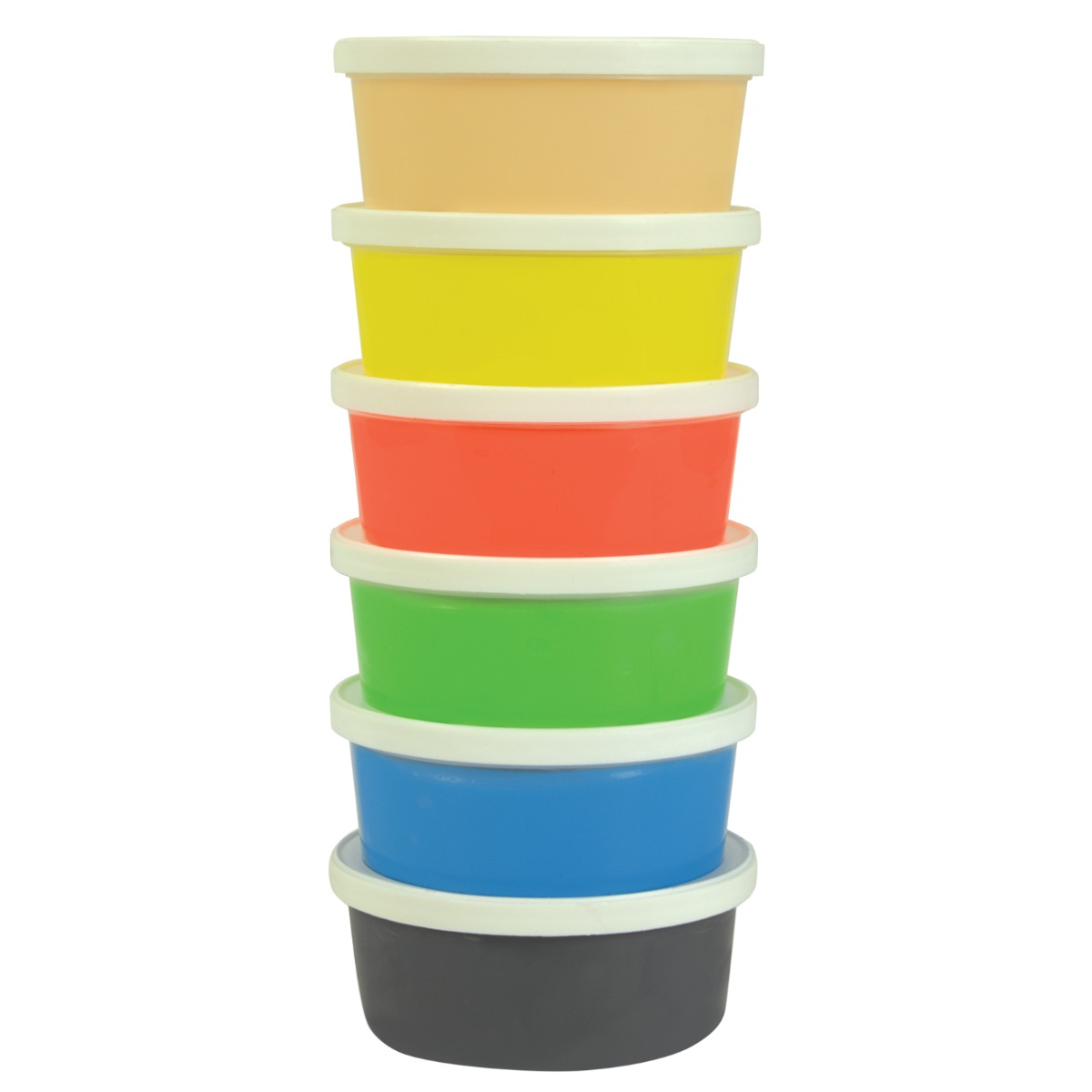
Some of the benefits of therapy putty include:
- Improved grip
- Increased finger strength
- Improved fine motor skills
- Increased thumb strength
- Sensory tactile input for children with sensory processing disorders or autism
- Calming manipulative tool so child can self-regulate
- Increased sensory awareness of what their hands are doing
- Fidget tool to help children with ADHD and other conditions to focus better
Why do these skills matter?
Fine motor skills allow your child to make movements using the small muscles in their hand and fingers. They are an important skill for many tasks like writing, getting dressed, cutting with scissors, drawing pictures, stringing beads, stacking blocks, and more every day and play activities. Along with arm and grip strength, these skills allow your child to brush their teeth, eat independently and more. Therapy putty helps strengthen fine motor skills and hand strength so your child can complete more tasks independently!
Putty can also be used to help children focus better in the classroom and when working on homework when used as a fidget tool. It’s also a calming tool to help children refocus and self-regulate when upset.
25 Therapy Putty Exercises & Activities
It might be best to set some basic rules before starting these exercises and activities with your child. Common rules include don’t put the putty in your mouth and don’t get down from the table when playing with your putty. If you don’t want your child to mix the therapy putty colors, let them know ahead of time or only give them one color at a time. Ready to get started?
9 Basic Putty Exercises
1. Finger Scissors: Place a ball of putty between two fingers and bring them together to “cut” the putty like you’re using scissors.
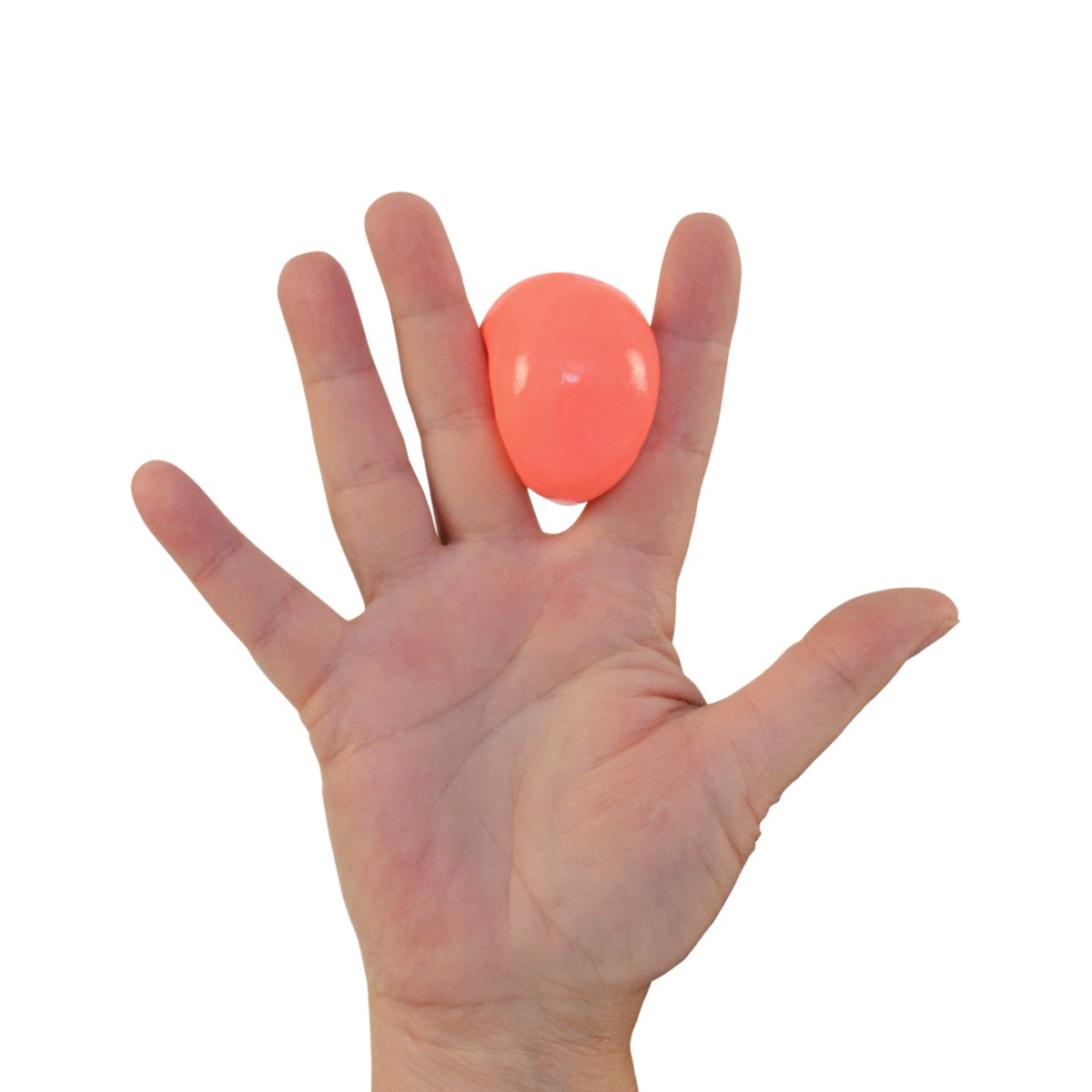
2. Fingertip Pinch: Place the ball of putty between your index finger, middle finger, and thumb and squeeze using your fingertips
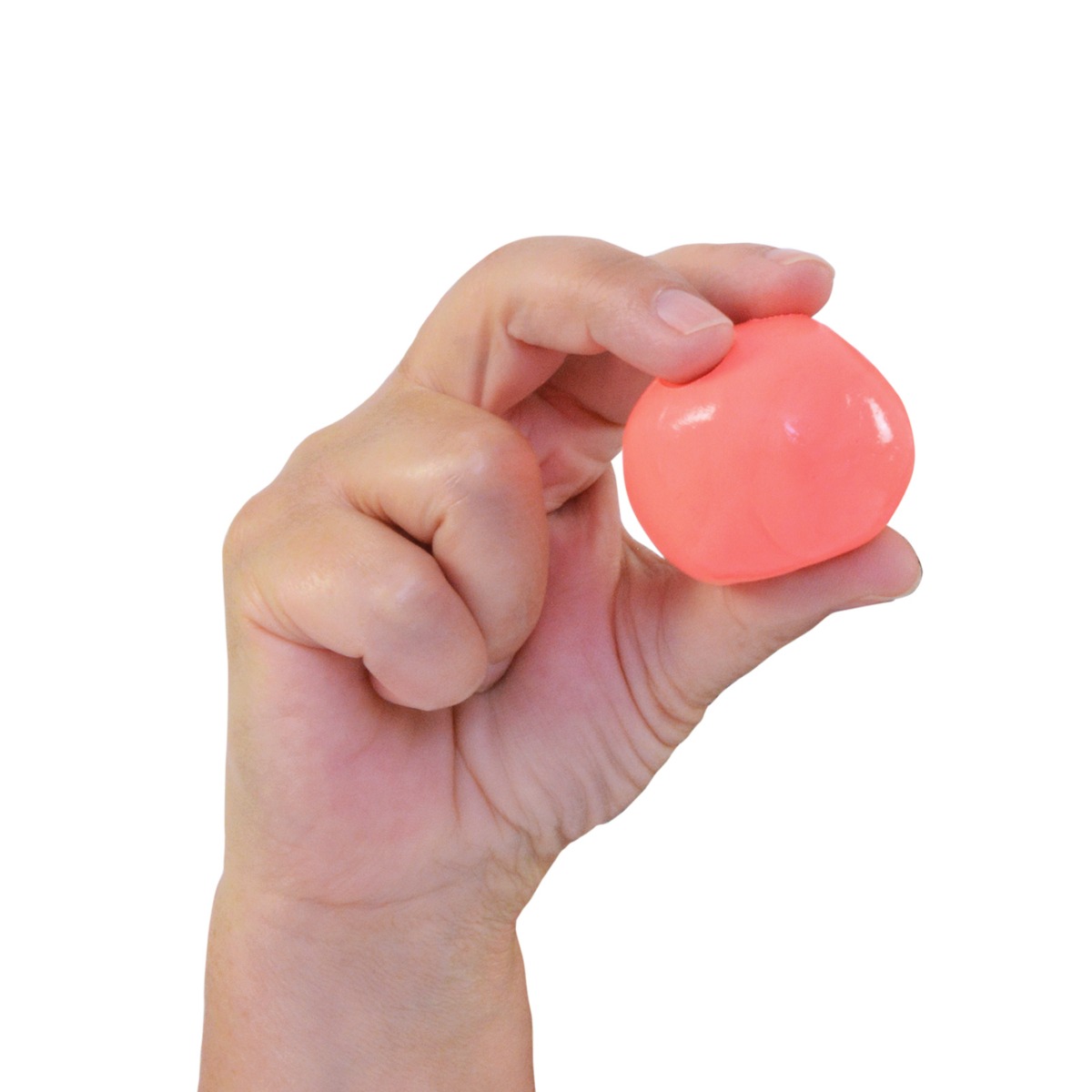
3. Flat Pinch: Hold a flat section of the putty with all your fingers on top and your thumb below, squeeze
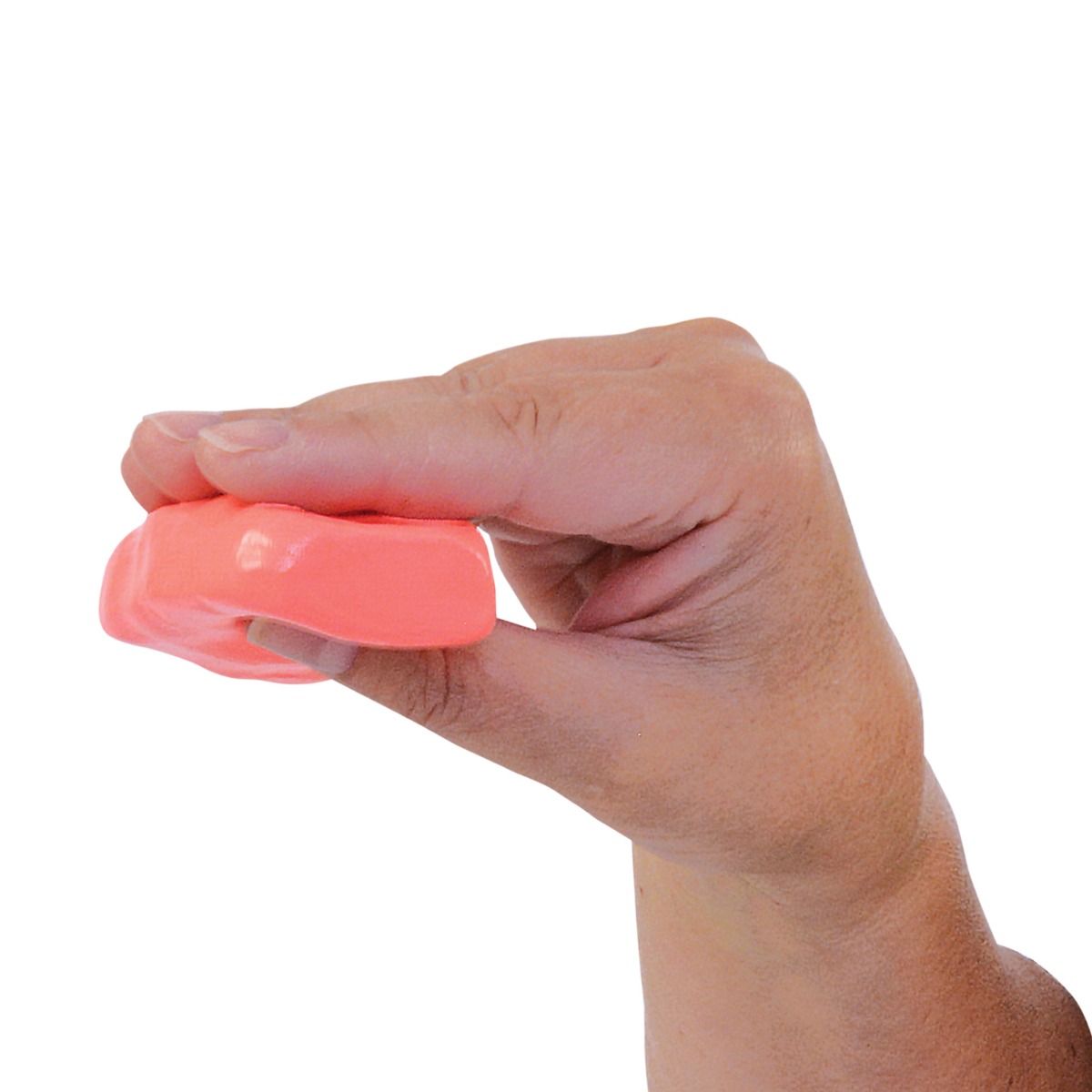
4. Finger Grip: Take a larger section of putty and hold it on your palm, squeeze using all four fingers
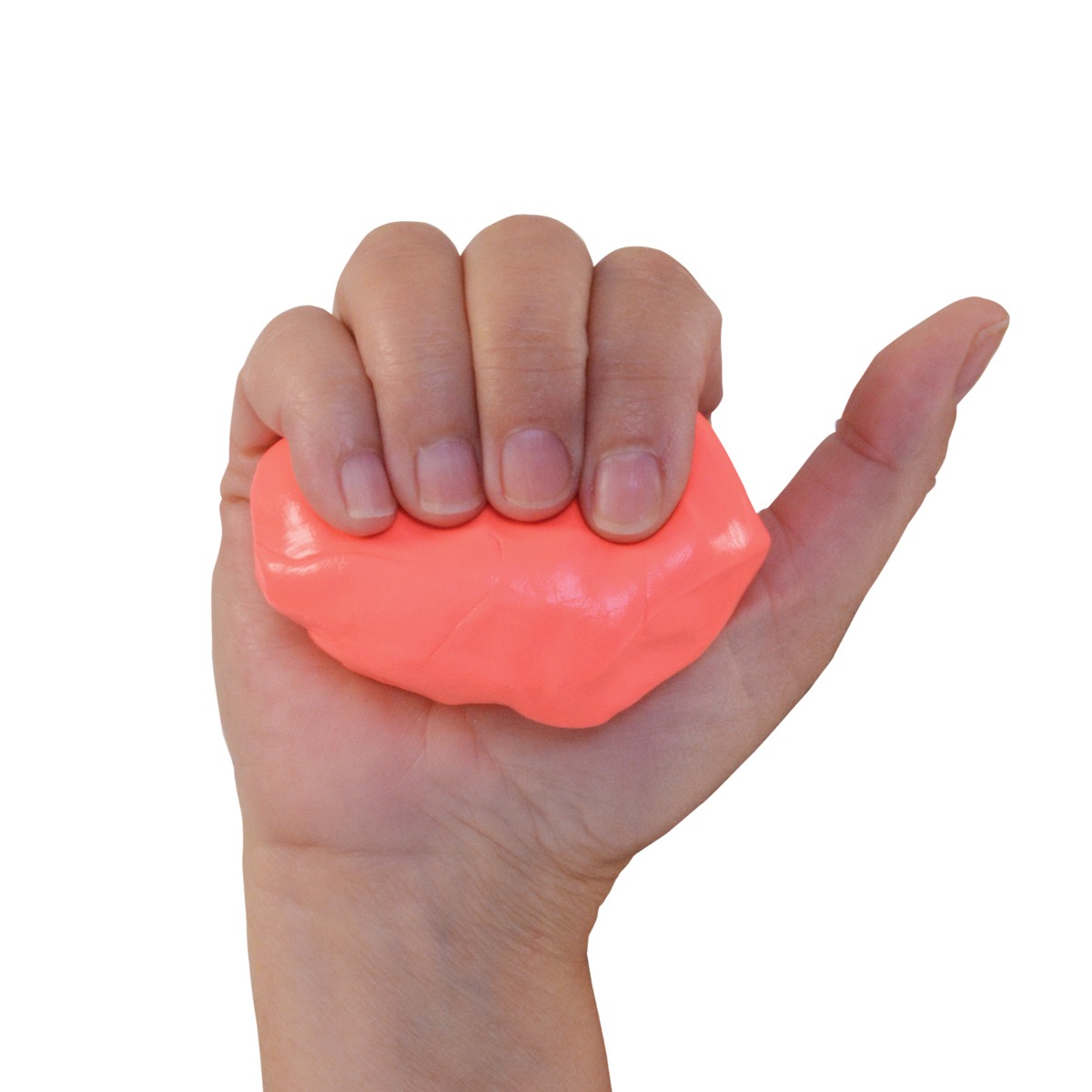
5. Power Grip: Similar to a finger grip, this exercise adds your thumb. Hold the putty on your palm and squeeze using your fingers and thumb
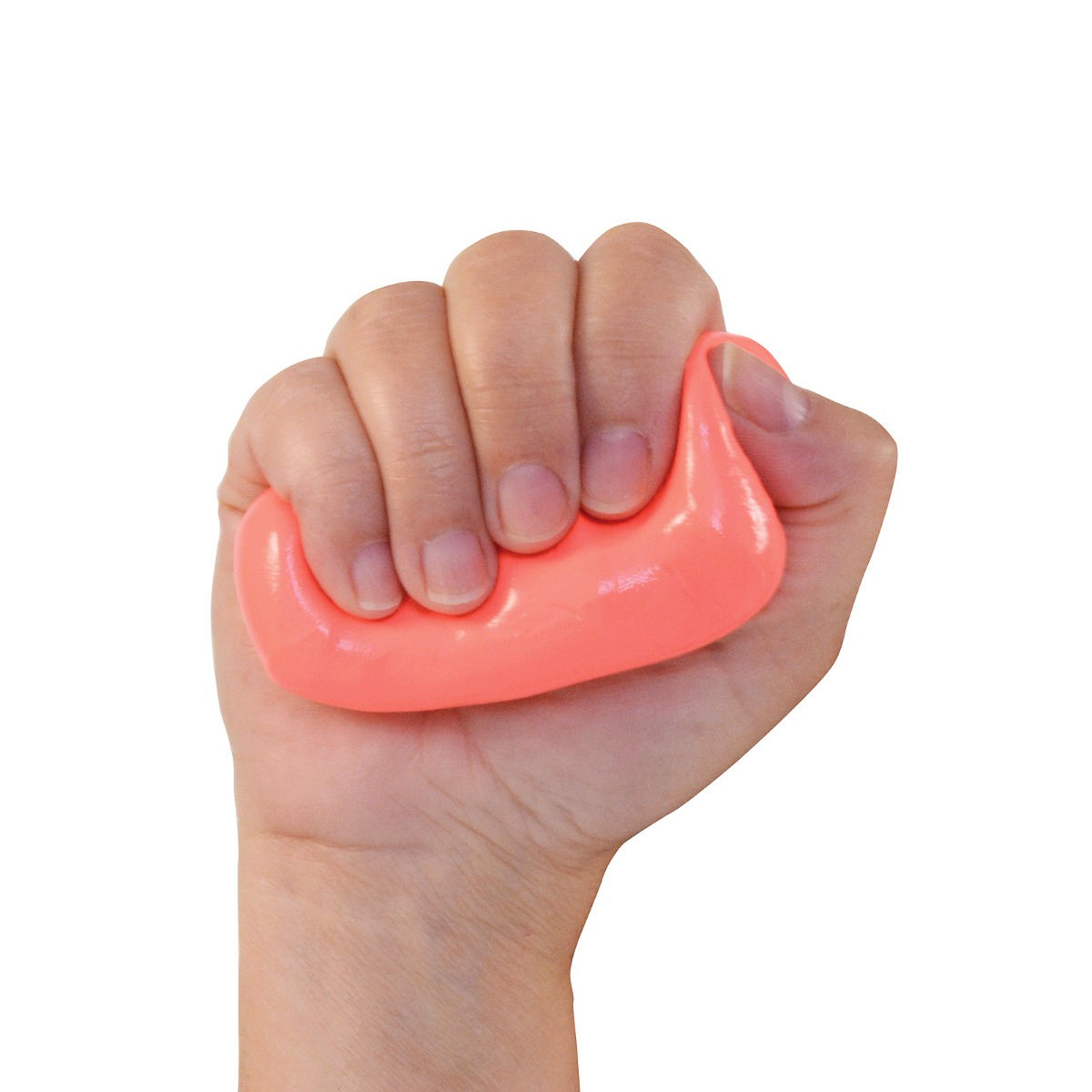
6. Finger Spread: Take the putty and roll it out to form a “snake”. Wrap the putty around two fingers or all four fingers and the thumb. Spread your fingers out to stretch the putty
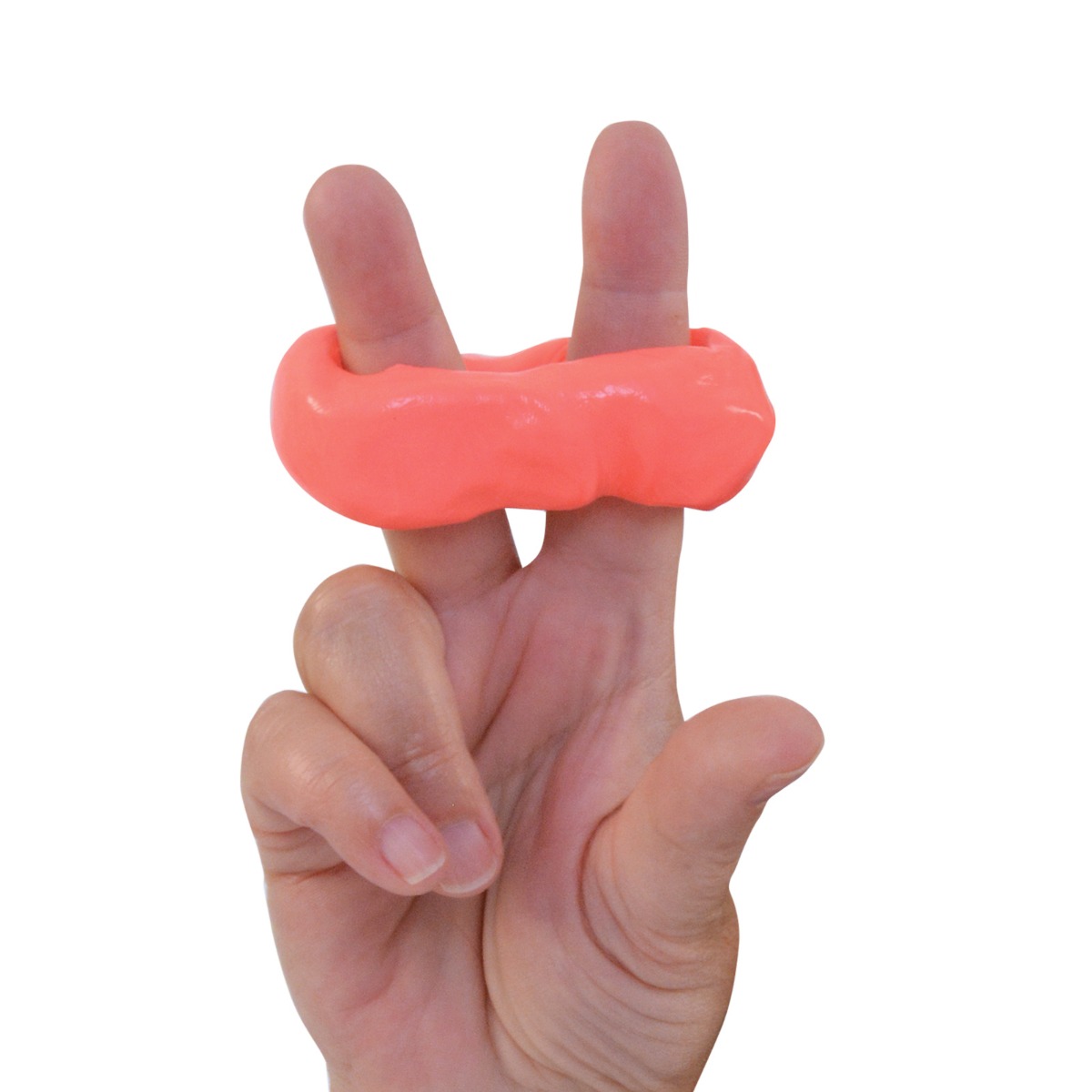
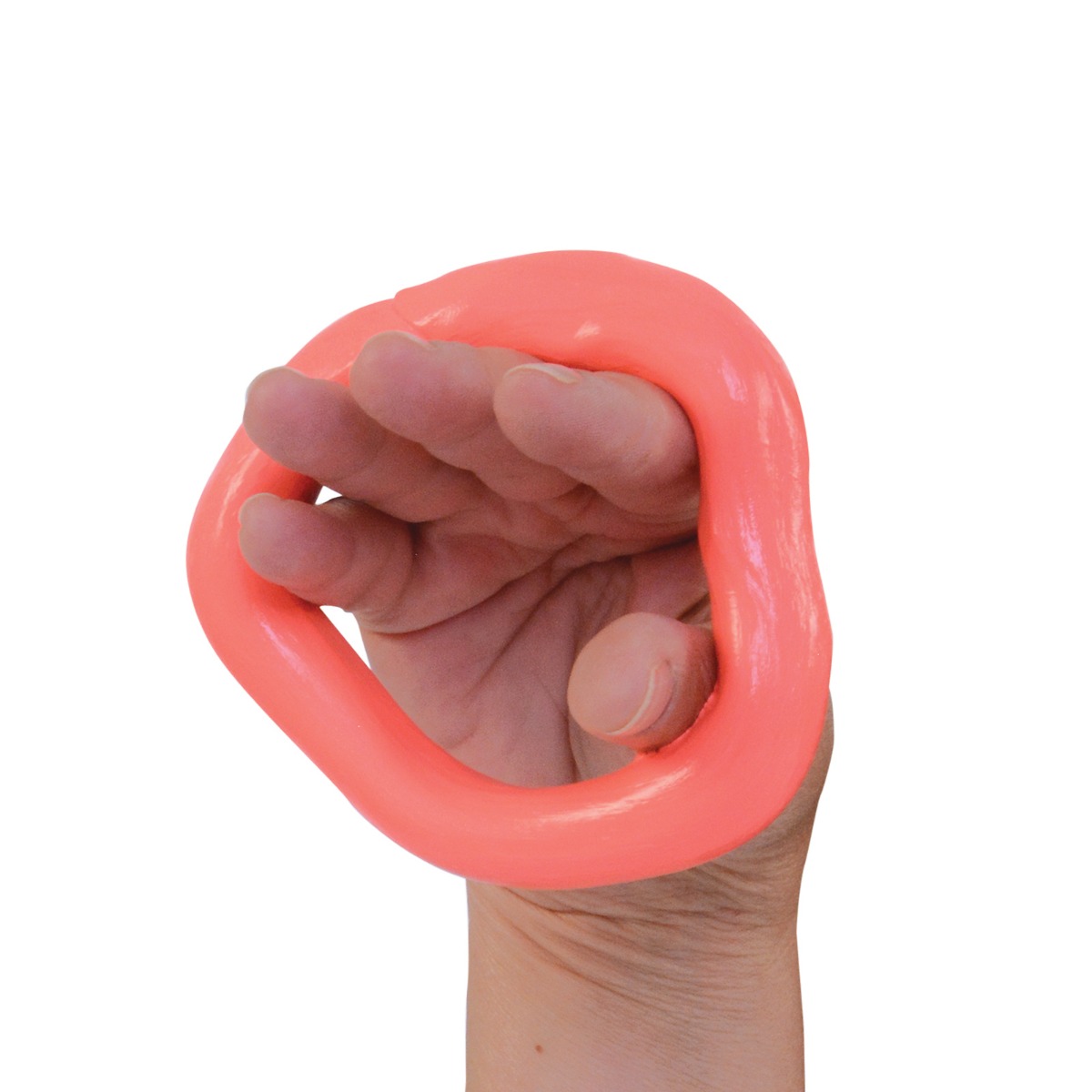
7. Finger Extension: Roll out the putty to form a “snake”. Wrap the putty around one finger and grip the bottom with the opposite hand. Extend your finger upward. This can be repeated on each of the other fingers
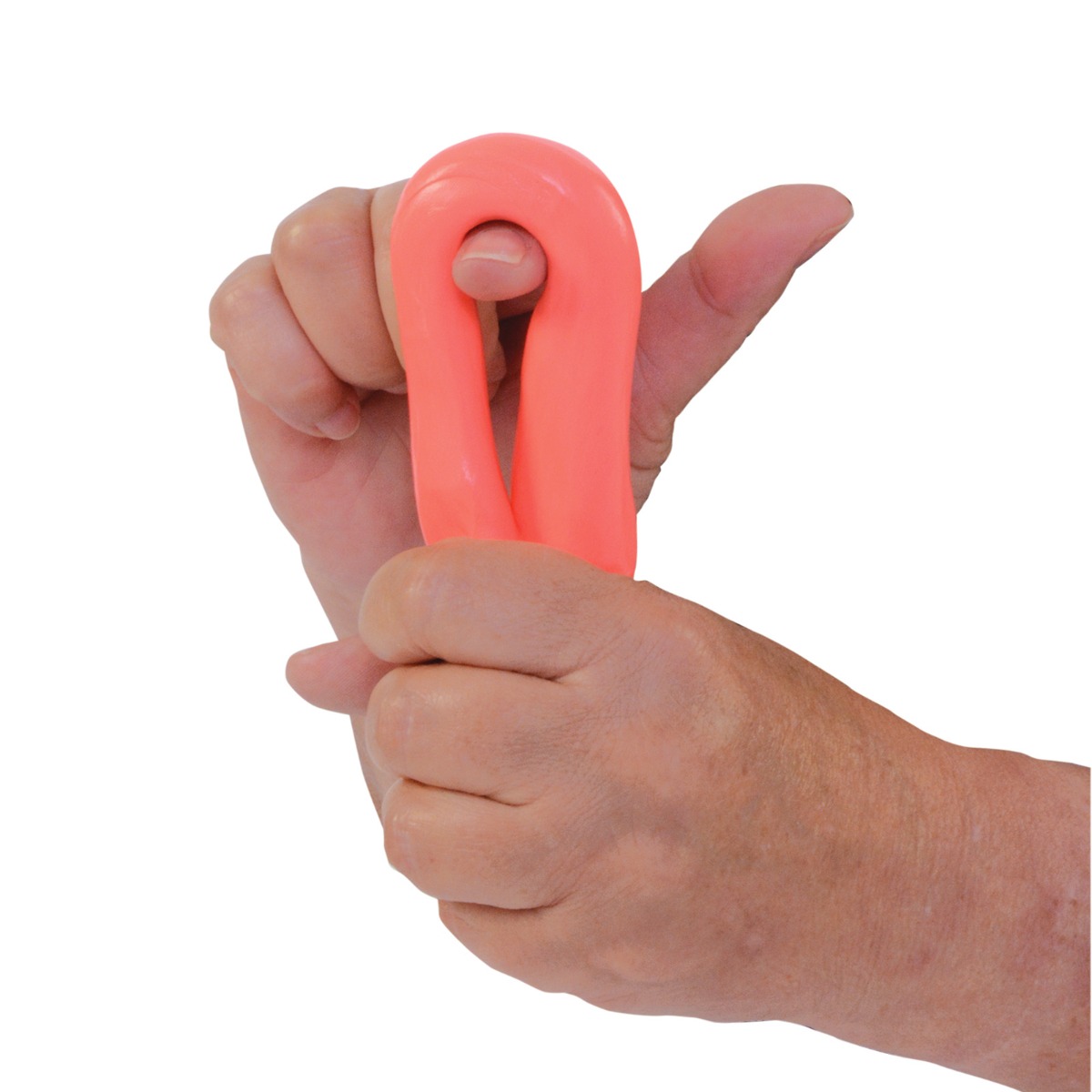
8. Thumb Extension: Roll the putty out to form a “snake”. Wrap the putty around your thumb and grip the bottom with the opposite hand. Extend your thumb upward
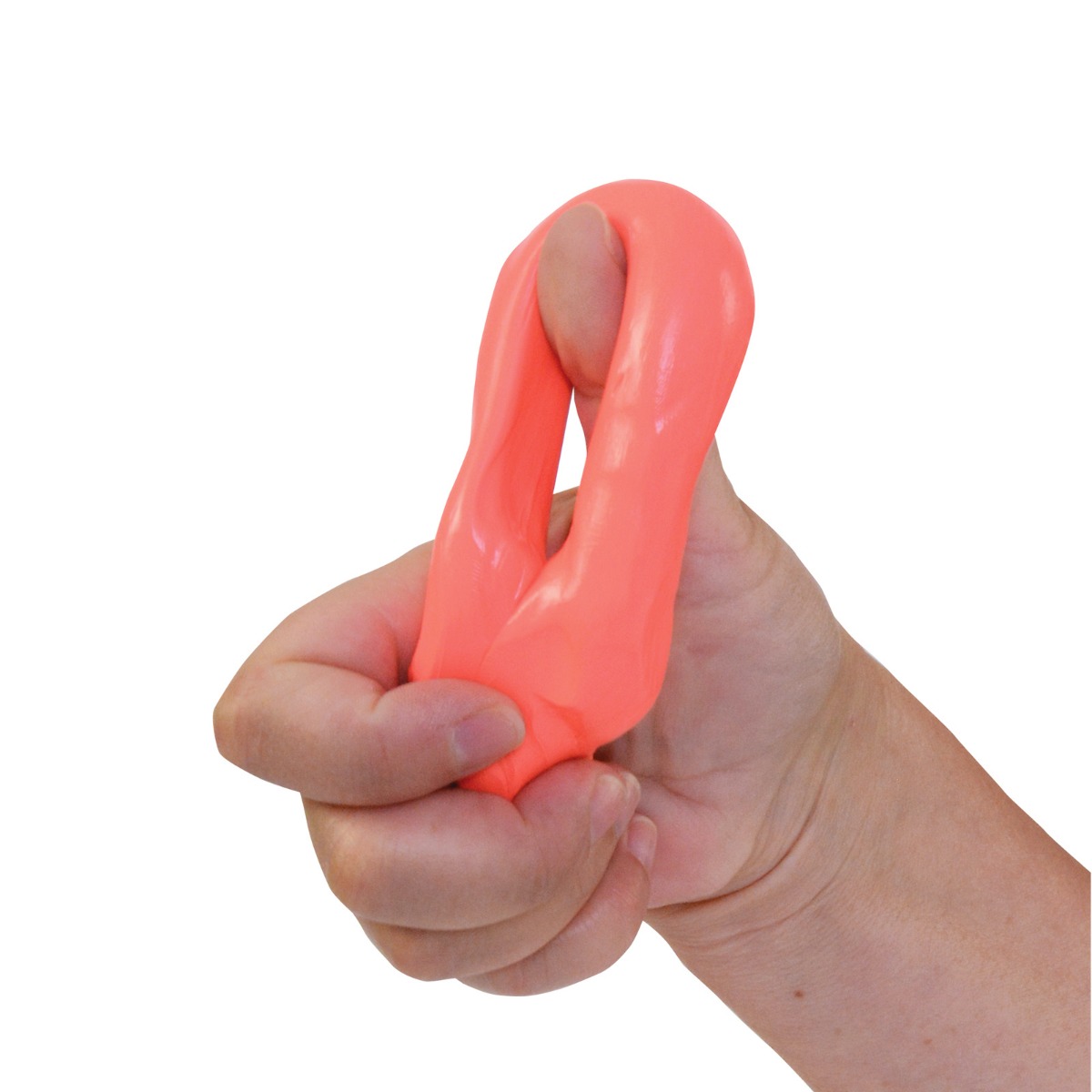
9. Twist: Roll the putty out into a cylindrical shape. Hold the end of the putty in one hand. Use your index finger, middle finger, and thumb of the opposite hand to pinch the top of the putty and twist. Repeat with the opposite hand
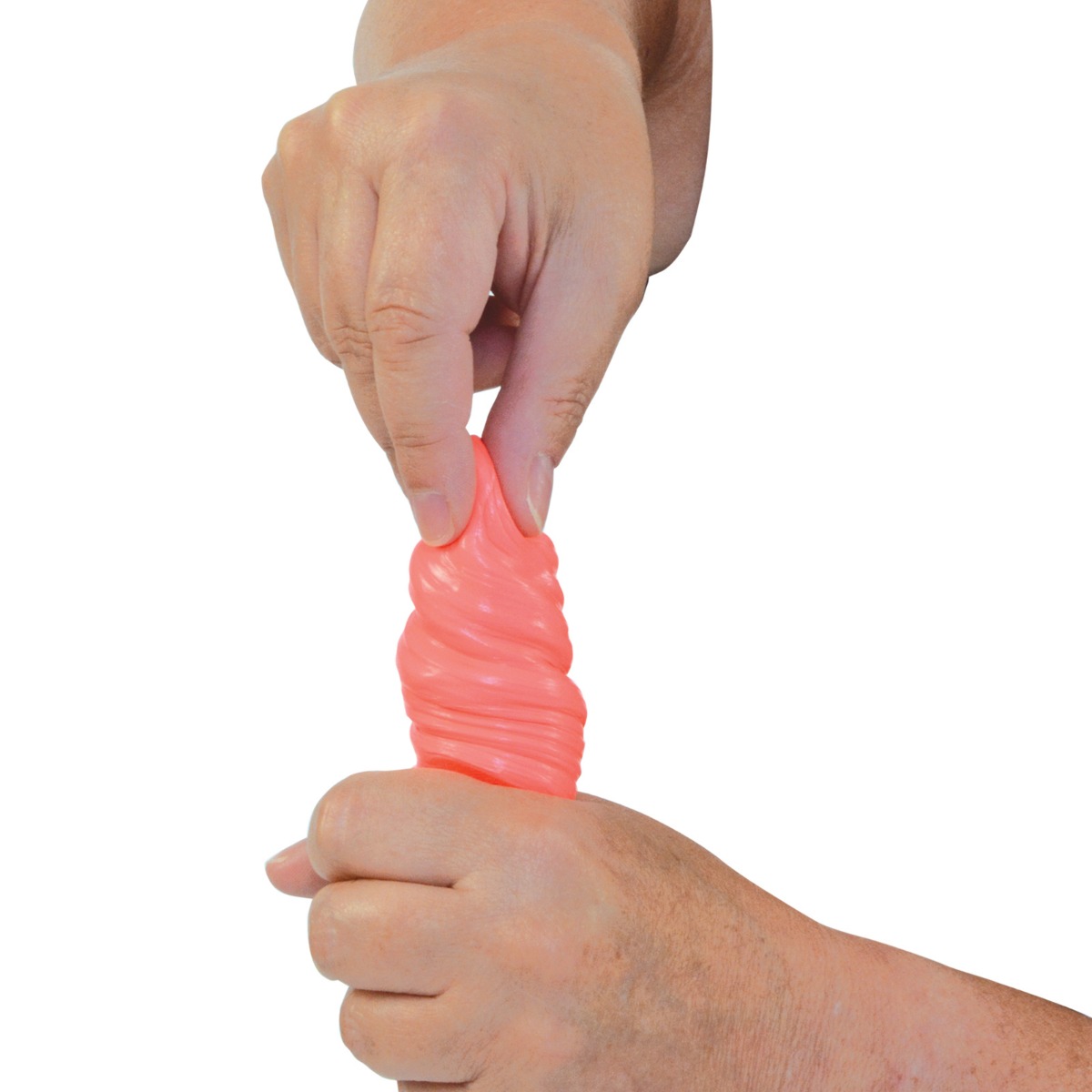
16 Fun Putty Activities
10. Hide-and-Seek: Hide small beads, plastic toys, erasers, or charms in the putty and then have your child dig them out
11. Letter Search: Hide foam letters in the putty and make matching cards for each letter. Your child can then flip over the card and search for the matching foam letter. For an extra challenge, time the card and if the letter isn’t found in time, flip the card back over
12. Make Confetti: Have your child pinch tiny amounts of putty to make confetti
13. Stamps: Have your child flatten out the putty. They can then use stamps to create scenes or write out words
14. Fit the Container: Give your child a lid or container and have them spread it out to fit the shape
15. Cookie Cutters: Have your child flatten out the therapy putty using their hands or a rolling pin and cut out fun shapes using cookie cutters. They’ll need to use their fine motor skills to roll the putty back into a ball and roll it out again to make more cookies
16. Find the Match: This game takes two people. The first person takes the putty and presses an impression of some object into it. The second person needs to guess what object made the impression
17. Ice Mold: Get an ice mold that features fun shapes and have your child put putty into the mold and try to extract it
18. Ziplock Bag Fun: Place the putty in your Ziplock bag. You can add sequins for fun sensory play and let your child push the sequins around to immerse them in the putty or draw a shape on the bag and have your child manipulate the putty to fit into the shape
19. Shapes: Have your child roll out the putty to make a “snake” and then manipulate putty to create shapes
20. Mix It Up: Get therapy putty of two different colors and let your child mix them to create a new color and resistance level
21. Make a Face: Draw a face shape onto a Ziplock bag. Mix two googly eyes, a bead, and a foam mouth in some putty and seal in in the bag. Have your child move the pieces around to make a face
22. Figure It Out: Place a picture or word under a Ziplock full of putty. Have your child move the putty until they can figure out the picture or word. Time them for an extra challenge
23. Doll Outfits: Have your child use the putty to create clothes for their plastic dolls
24. Find the Star: Place a foam star and several other similar foam shapes into the putty and mix it up, have your child pull and manipulate the putty to find the star. You could also do this using different sequins, small toys, or whatever your child enjoys
25. Free Play: Ask your child if they have any fun ideas on how to use their therapy putty and incorporate the activities into your child’s putty playtime. Maybe they want to smush one piece flat to make a pizza and tear off small pieces to act as cheese and other toppings. Or roll it out to create spaghetti snakes and round meatballs. If your child likes animals better, try making a caterpillar, spider, snail, or puppy
See some of these activities in practice and learn a new one in this video!
How to Choose the Right Therapy Putty
There are a lot of therapy putty options and resistances for your child. Having a variety of putty types at home helps mix up your child’s hand therapy routine and makes grip and finger strengthening more fun. The variety also means that if your child doesn’t enjoy one putty’s texture, they can try another (or try using it in a ziplock bag).
You can also choose from different resistances that allow your child to challenge themselves as they grow stronger. Most therapy putty will offer four to six basic resistance levels. The six levels are typically extra soft, soft, medium-soft, medium, firm, and extra firm. If there are only four levels, they are usually the middle four from that list. Sammons Preston Therapy Putty comes in six different resistances.
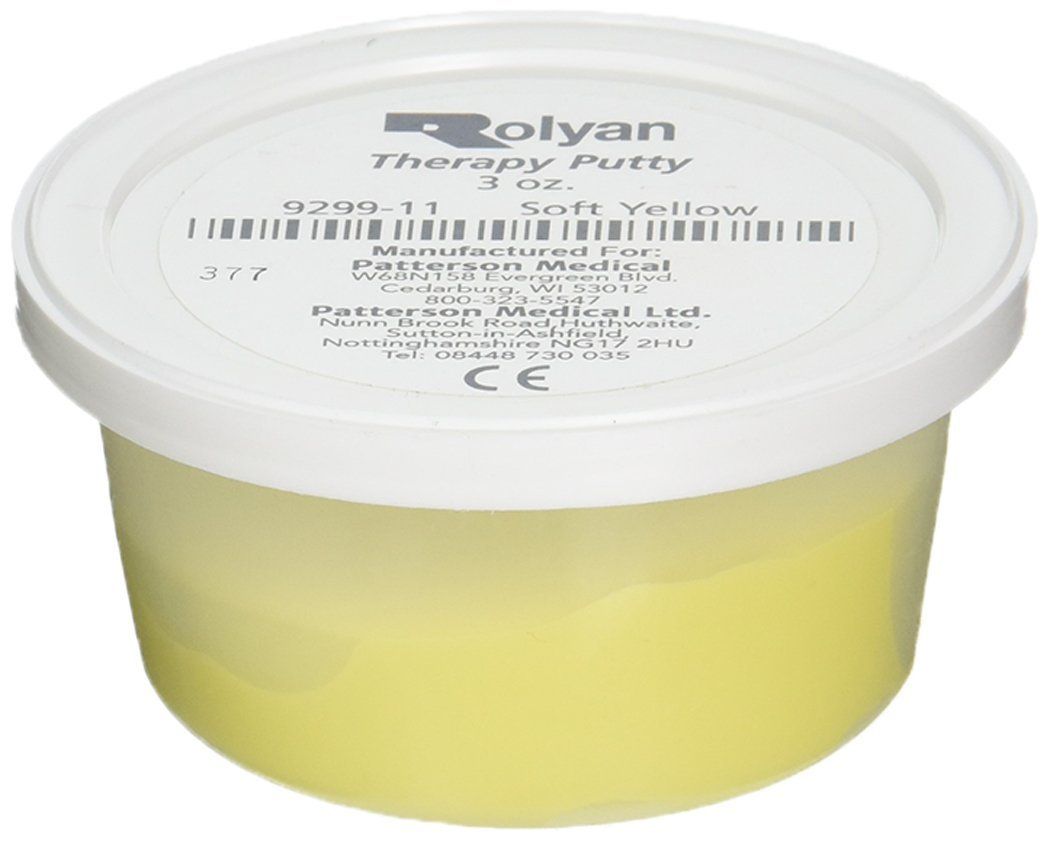

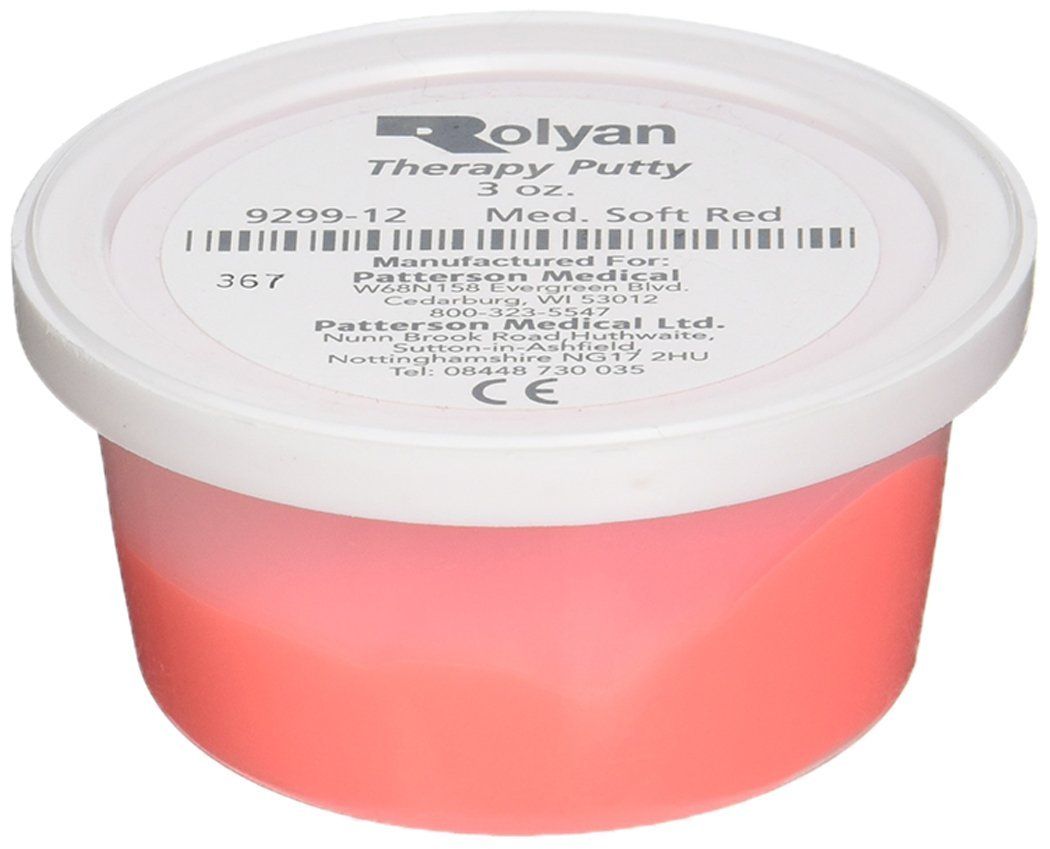

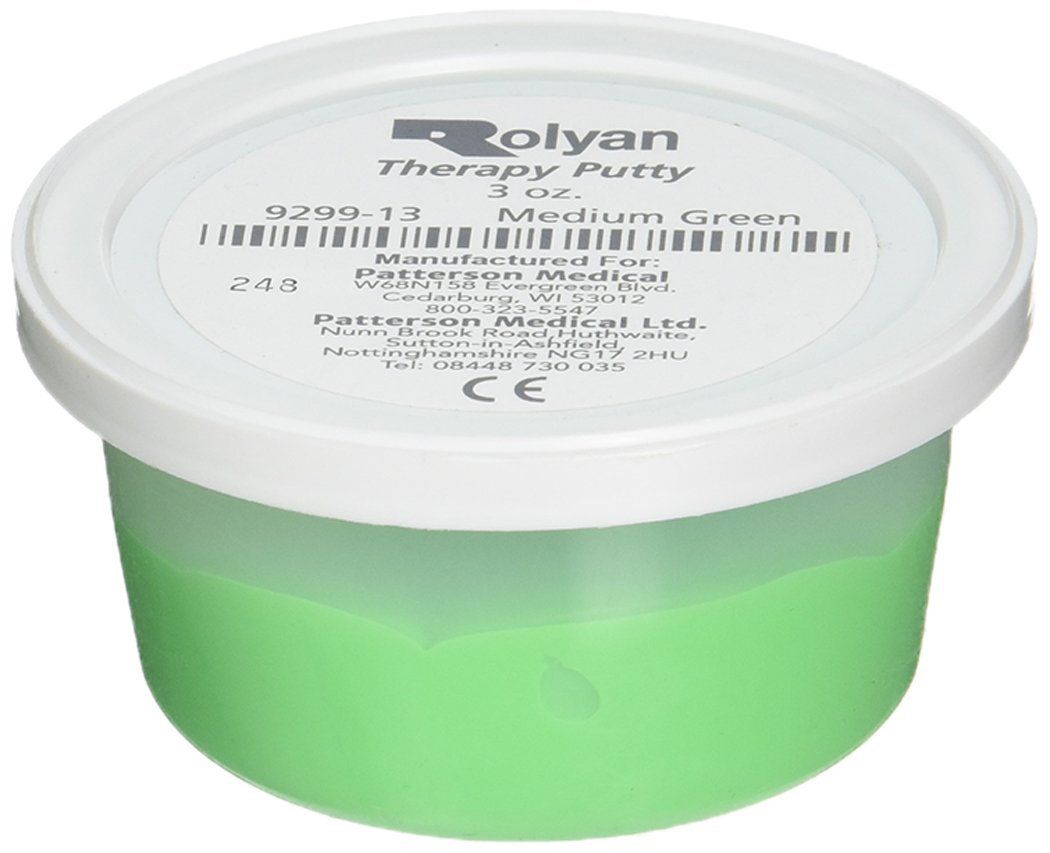

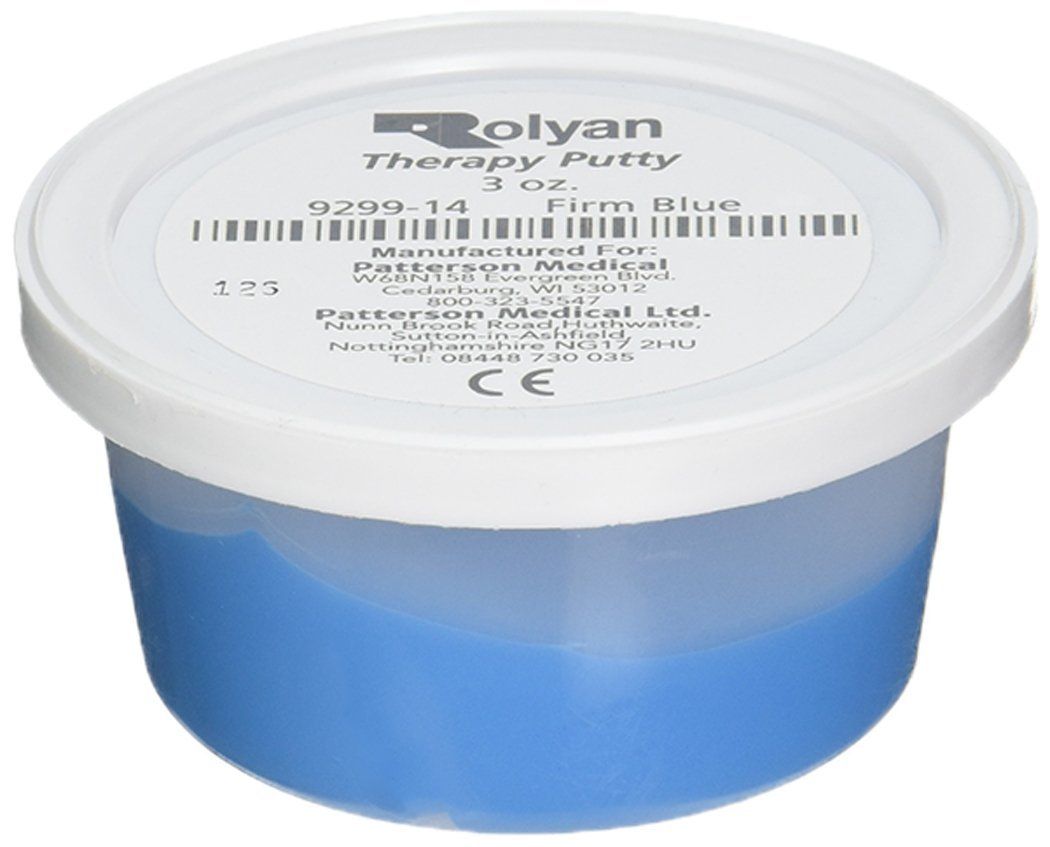

If you have questions about what putty to choose, talk to your child’s therapist.
Here are some of your putty options:
- Sammons Preston Therapy Putty: This basic putty is a great starting point. It comes in 6 colors; each one is a different resistance level from super soft to extra firm. Choose from many different sizes and start your putty exercises now
- Air-Putty: If your child doesn’t like the texture of standard putty, they might prefer this Air-Putty. It’s less oily and offers a different sensory experience
- Sammons Preston Color Change Putty: As you work with this putty, it gradually changes color! The heat from your hands working the putty causes it to change color from orange to yellow or royal blue to light blue. When not in use, the putty returns to its original color so it’s ready for more play
- Sammons Preston Progressive Putty: Forget about buying a bunch of different resistances! All you need is this putty and the progress chips. As your child’s hands grow stronger, you can mix in another progress chip
References
- Sensory Living. (n.d.). Theraputty- The Hand Workout. Retrieved from https://bit.ly/2WBaE40
- The Understood Team. (n.d.). Fine motor skills: What you need to know. Understood. Retrieved from https://u.org/38qvdWt
- George, C. (n.d.). 21 Silly Putty & Therapy Putty Activities. Childhood 101. Retrieved from https://bit.ly/38xtmzf
- George, C. (n.d.). Silly Putty Recipe & 10 Putty Play Ideas. Childhood 101. Retrieved from https://bit.ly/3hbKdv7
- Theraputty Hand Strength Exercises. NHS Greater Glasgow and Clyde. Retrieved from https://bit.ly/3hiCyv9
Medical Disclaimer: The information provided on this site, including text, graphics, images and other material, are for informational purposes only and are not intended to substitute for professional medical advice, diagnosis or treatment. Always seek the advice of your physician or other healthcare professional with any questions or concerns you may have regarding your condition.








 France
France Australia
Australia